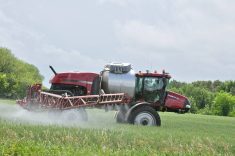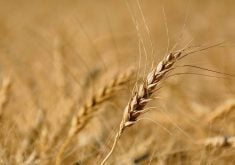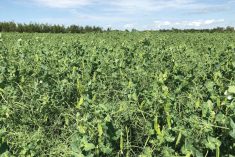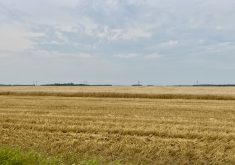Fusarium head blight has damaged some of Western Canada’s early-harvested spring and durum wheat, but it’s too soon to know the full extent.
Daryl Beswitherick, the Canadian Grain Commission’s (CGC) program manager for quality assurance standards and reinspection, said they’ve been seeing signs in the early results from their harvest sampling program.
“It is definitely present,” Beswitherick said in an interview Sept. 7. “We have seen some good No. 1, but there is definitely more that is being downgraded to No. 2 and 3 and feed wheat than there is No. 1.
Read Also

Manitoba sclerotinia picture mixed for 2025
Variations in weather and crop development in this year’s Manitoba canola fields make blanket sclerotinia outlooks hard to pin down
“There is a lot of crop to be taken off yet (especially in Saskatchewan and Alberta) so it is really hard to say how widespread it is.”
Fusarium, the yield- and quality-robbing fungal disease, is showing up even in Alberta where it’s usually not a problem, Beswitherick said.
“We have seen a few samples in areas that we have never seen fusarium in before,” he added.
As the CGC receives more harvest samples it will get a better handle on how widespread and damaging the infection has been, he said.
The good news is there’s little fusarium damage in winter wheat, Beswitherick said.
Spring and winter wheat are susceptible to fusarium head blight at the flowering stage. Much of Western Canada’s winter wheat crop might have flowered before humid weather conditions allowed the fungal disease to infect the crop.
Some varieties of winter and spring wheat are more tolerant to fusarium than others. And spraying a fungicide at early flowering can also help protect wheat crops against fusarium head blight. But despite genetic tolerance and fungicides, sometimes the disease pressure is so strong wheat crops are still heavily damaged.
Fusarium has damaged spring wheat and barley crops in southwest Manitoba, Lionel Kaskiw, Manitoba Agriculture’s Souris-based farm production adviser, said during the Crop Talk Westman webinar Sept. 7.
“I think No. 1 will be very rare (in our area) because of fusarium and weathering,” he said
Moreover, the mycotoxin deoxynivalenol (DON), also known as vomitoxin, a frequent byproduct of fusarium head blight, has been detected in some crops.
“It is probably more of an issue in the barley right now than in the wheat,” Kaskiw said in an interview. “We are getting some pretty high levels of vomitoxin coming back in barley right now.”
Kaskiw suspects fewer farmers sprayed a fungicide to protect barley, because it’s less susceptible to the disease. However, this growing season’s warm, humid conditions were ideal for the disease and existed longer than normal, extending the time barley could be infected.
“Basically this year we had a whole month of prime conditions (for fusarium),” he said.
“Whether you planted early or planted late, conditions were probably such that fusarium was going to affect you.”
Several other conditions cause damage to kernels similar to fusarium, Kaskiw said. In wheat these include midge injury and the disease glume blotch.
In barley it’s net and spot blotch.
CGC tolerances for fusarium-damaged kernels (FDK) — a proxy for DON — is low in Canada Western Red Spring wheat, Canada’s top milling wheat class. No. 1 is allowed a maximum 0.25 per cent fusarium; No. 2, 3 and Canada Western Feed are allowed 0.8, 1.5 and four per cent, respectively.
The tolerances for fusarium damage in barley is low too — just 0.2 per cent in Canada Western select malting (two and six row), 0.5 per cent in CW Select Food and 1.0 per cent in No. 1 and 2 Canada Western General Purpose barley.
But most grain buyers will test the wheat and barley for DON, Kaskiw said.
Most buyers require wheat destined for human consumption to contain levels of no more than one part per million DON.
“It depends who you are selling to,” he added. “Some markets want lower than that. I have heard of some as low as 0.5 parts per million and you might get some that are a little bit higher. But in general the one part per million is usually what you’ll be looking for if it is going into the human consumption market. Right now we have a lot of wheat that is being checked that is close to that one part per million. It is going to be interesting to see how we progress through the rest of the year.”
One part per million is equivalent to one pound in a million, or one kernel in 80 pounds of wheat, he said.
Often DON-infected kernels are lighter and blow out the back of the combine. Cleaning can also reduce DON levels, but it usually requires more modern equipment such as a gravity table or a system using air to remove lighter seeds, Kaskiw said.
Colour sorters work too, but are more expensive, he added. But in some cases it might be worth it. Kaskiw has heard stories of farmers who were expecting $5 a bushel for malting barley, but will earn just $2.50 because of high DON levels.
When DON exceeds one part per million the infected grain usually goes for livestock feed, Kaskiw said.
Feeder cattle can safely consume 18 parts per million, while breeding beef cows and poultry can handle five parts per million, he said.
Dairy cattle can be fed two parts per million.
Pigs are the least tolerant. Gestating or lactating sows, or pigs weighing less than 50 pounds, are restricted to one part per million.
“The biggest thing producers need to do is have a good, representative sample of what they are selling,” Kaskiw said.
That way the farmer and seller both know what they’ve got and neither will be surprised later. Most buyers will test every load of fusarium-damaged grain they purchase, he added.




















